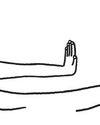
“Princess X” (1915-16), the phallic-feminine sculpture that shocked Paris.
I am writing about Constantin Brancusi on a machine with rounded corners. Chances are good that you own such a machine, too. Mine is mostly aluminum, but the surface has the faint roughness of ancient stone. The aesthetic, which might be described as austere yet playful, seems right for an object that is both a serious, grownup device and a toy. At different times, it has symbolized human ingenuity, American pluck, sweatshop barbarism, the glorious future, and screen addiction.
My point isn’t that Brancusi, the star of a euphoric retrospective at the Centre Pompidou in Paris, invented this aesthetic in his sculptures. More than a hundred years ago, though, he perfected a kind of earthy sleekness that still looks embarrassingly contemporary, so fresh that it makes the actual present taste stale. Its peak, against strong competition, can be found in the sixteen svelte, polished, ridiculously cool versions of “Bird in Space” that he made between 1923 and 1940. Some are bronze, some are marble. All could be tinted air. Their shape is something between a quill and a cobra, though maybe it’s better to say that they look the way flight feels, or the way flight should feel but never quite does.
Diese Geschichte stammt aus der June 03, 2024-Ausgabe von The New Yorker.
Starten Sie Ihre 7-tägige kostenlose Testversion von Magzter GOLD, um auf Tausende kuratierte Premium-Storys sowie über 8.000 Zeitschriften und Zeitungen zuzugreifen.
Bereits Abonnent ? Anmelden
Diese Geschichte stammt aus der June 03, 2024-Ausgabe von The New Yorker.
Starten Sie Ihre 7-tägige kostenlose Testversion von Magzter GOLD, um auf Tausende kuratierte Premium-Storys sowie über 8.000 Zeitschriften und Zeitungen zuzugreifen.
Bereits Abonnent? Anmelden

BADDIE ISSUES
\"Wicked\" and \"Gladiator II.\"

LET'S MAKE A DEAL
\"Death Becomes Her\" and \"Burnout Paradise.\"

ANTI HEROES
\"The Franchise,\" on HBO.

FELLOW-TRAVELLERS
The surprisingly sunny origins of the Frankfurt School.

NOW YOU SEE ME
John Singer Sargent's strange, slippery portraits of an art dealer's family.

PARIS FRIEND - SHUANG XUETAO
Xiaoguo had a terror of thirst, so he kept a glass of water on the table beside his hospital bed. As soon as it was empty, he asked me to refill it. I wanted to warn him that this was unhealthy - guzzling water all night long puts pressure on the kidneys, and pissing that much couldn't be good for his injury. He was tall, though, so I decided his insides could probably cope.

WILD SIDE
Is Lake Tahoe's bear boom getting out of hand?

GETTING A GRIP
Robots learn to use their hands.

WITHHOLDING SEX FROM MY WIFE
In the wake of [the] election, progressive women, who are outraged over Donald Trump's victory at the ballot box, have taken to social media with public, vengeful vows of chastity. - The Free Press.

DEADLINE EXTENSION
Old age, reborn.